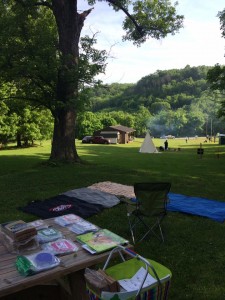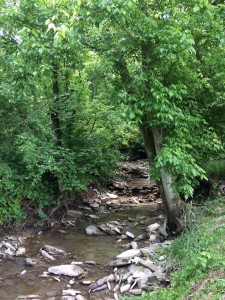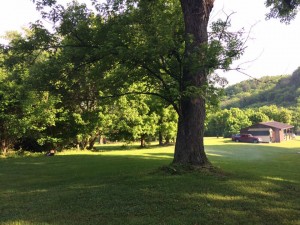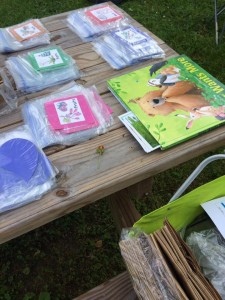 For the second time in as many years, I had the opportunity to participate in the Outdoor Classroom Trip for a local school district. This event has happened annually at the end of the school year for 11 years, and is run by the science teacher at Kathryn Winn Primary School, which is part of the Carroll County school district. The Outdoor Classroom is owned by a local family, open to use by the schools, and is very close to Carrollton, KY, where the school is located. The day makes use of volunteers from the high school, many teachers, parents, local businesses, and program providers, of which I am one. The teacher behind the Trip, Gail Becraft, and I met through a Kentucky Association for Environmental Education (KAEE) event several years ago, which led to the invitation to participate for the first time last year.
For the second time in as many years, I had the opportunity to participate in the Outdoor Classroom Trip for a local school district. This event has happened annually at the end of the school year for 11 years, and is run by the science teacher at Kathryn Winn Primary School, which is part of the Carroll County school district. The Outdoor Classroom is owned by a local family, open to use by the schools, and is very close to Carrollton, KY, where the school is located. The day makes use of volunteers from the high school, many teachers, parents, local businesses, and program providers, of which I am one. The teacher behind the Trip, Gail Becraft, and I met through a Kentucky Association for Environmental Education (KAEE) event several years ago, which led to the invitation to participate for the first time last year.
The location is pretty amazing. Situated on several fairly steep hillsides, it includes a couple large, open, mowed hills, a deck-like platform area near the top of one of the hills, wooded space, a creek, a shelter with picnic tables, and more open space both in shade and sun. The school owns a tee-pee, which is set up in the middle of one of the hills; and there is plenty of space for the various stations set up throughout. There are restrooms and portables on site, and medical services on site for the day as well. The students arrive from the school on
wooded space, a creek, a shelter with picnic tables, and more open space both in shade and sun. The school owns a tee-pee, which is set up in the middle of one of the hills; and there is plenty of space for the various stations set up throughout. There are restrooms and portables on site, and medical services on site for the day as well. The students arrive from the school on  buses.
buses.
The Food for Bears station is based on an activity I adapted from Growing Up WILD (Project WILD), called Lunch for a Bear. The printouts for the activity can be found here: http://www.projectwild.org/growingupwild/documents/Lunch_for_a_Bear.pdf
I begin with a story- last year I used the title A Bear’s Year, by Kathy Duval (found  here: http://kathyduval.com/books/a-bears-year/ ).
here: http://kathyduval.com/books/a-bears-year/ ).
This year, I chose the story Bear Wants More, by Karma Wilson, which can be found  here: http://www.karmawilson.com/books/bear/more.htm . Both books touch on the habitat and foods of bears in a general way, and make good introductions to the game. By way of further introduction, we talk about what kinds of foods bears eat that people might also eat. I have laminated photos of various “bear foods” to illustrate this concept. With the kindergartners, it is interesting to note how many react with “ew, no!” when asked if they might eat plants! We then talk about various things most people eat that are or come from plants… including berries, nuts, lettuce, vegetables, and even french fries. One thing that omnivorous bears eat that most people do not is insects, which causes interesting reactions as well. We talk about what it means to be carnivores, herbivores, and omnivores. We also talk about the need for all living things to have access to water, and then talk about the four requirements for habitat.
here: http://www.karmawilson.com/books/bear/more.htm . Both books touch on the habitat and foods of bears in a general way, and make good introductions to the game. By way of further introduction, we talk about what kinds of foods bears eat that people might also eat. I have laminated photos of various “bear foods” to illustrate this concept. With the kindergartners, it is interesting to note how many react with “ew, no!” when asked if they might eat plants! We then talk about various things most people eat that are or come from plants… including berries, nuts, lettuce, vegetables, and even french fries. One thing that omnivorous bears eat that most people do not is insects, which causes interesting reactions as well. We talk about what it means to be carnivores, herbivores, and omnivores. We also talk about the need for all living things to have access to water, and then talk about the four requirements for habitat.
While this talk is taking place, empty paper lunch bags are being handed out to all the students. It is explained that they are bears sitting in their dens, and are just waking up from hibernation. After talking some about the idea of waking up hungry in the morning and translating that to what it must feel like to wake up after sleeping through the whole winter, we establish that the lunch bags are their “bear stomachs” and if they check, they will find they are empty. It’s time to fill up those bear bellies!
 I have colored, cut out, and glued to differently colored construction paper the different bear food cards from the Lunch for a Bear activity. Each food category has its own color, and all cards are sealed in plastic sandwich bags so that I can re-use them. Once the story has been read and the categories of food discussed, the food cards are randomly spread over the ground, and the “bears” are awakened from their hibernation. After some stretching and growling, they climb from their dens to forage for food. The idea is to find one of each of the 5 types of food: meat, insects, nuts, plants, fruits; plus water. The instruction is to locate one of each, put them in their bear bellies, and return to the den. We then talk about carrying capacity, and what happens if the bears are not able to find all the various types of food and water. I compare eating pizza all the time, only pizza, with what happens if a bear can’t find all the types of food. It might live that way, but it won’t be as healthy as it should be. If there is time, we collect the food cards, then play again, this time with fewer total food cards, or with no water, or with very few of one specific food or water. Then we talk about what happens when some of the bears don’t find enough food or water. To stretch the carrying capacity point a little, I also ask the students to imagine if we played the same game again, with the same cards, but added all rest of the students at the Outdoor Classroom to the game at the same time. This makes the point that adding more bears to the same space doesn’t always work, and relates back to the carrying capacity and four needs of habitat.
I have colored, cut out, and glued to differently colored construction paper the different bear food cards from the Lunch for a Bear activity. Each food category has its own color, and all cards are sealed in plastic sandwich bags so that I can re-use them. Once the story has been read and the categories of food discussed, the food cards are randomly spread over the ground, and the “bears” are awakened from their hibernation. After some stretching and growling, they climb from their dens to forage for food. The idea is to find one of each of the 5 types of food: meat, insects, nuts, plants, fruits; plus water. The instruction is to locate one of each, put them in their bear bellies, and return to the den. We then talk about carrying capacity, and what happens if the bears are not able to find all the various types of food and water. I compare eating pizza all the time, only pizza, with what happens if a bear can’t find all the types of food. It might live that way, but it won’t be as healthy as it should be. If there is time, we collect the food cards, then play again, this time with fewer total food cards, or with no water, or with very few of one specific food or water. Then we talk about what happens when some of the bears don’t find enough food or water. To stretch the carrying capacity point a little, I also ask the students to imagine if we played the same game again, with the same cards, but added all rest of the students at the Outdoor Classroom to the game at the same time. This makes the point that adding more bears to the same space doesn’t always work, and relates back to the carrying capacity and four needs of habitat.
Before moving on to the next session, groups are taught the song “The Bear Went Over the Mountain” with variations about their food. We repeat the vocabulary words. Even though we are talking about some higher-level scientific concepts, the game makes the point clear… even for kindergartners. And they have a great time pretending to be hungry bears.
To extend the bear theme, additional bear related activities based on the book A Bear’s Year can be found at Curious City DPW, here: http://www.curiouscitydpw.com/2015/11/15/a-bears-year-read-aloud-kit/.




Leave A Comment